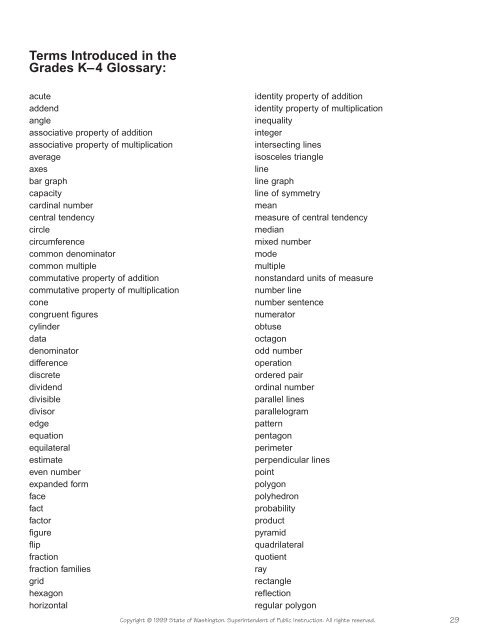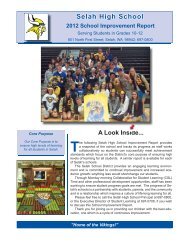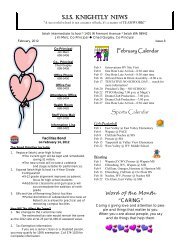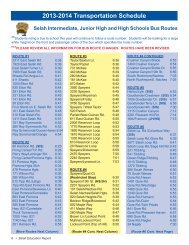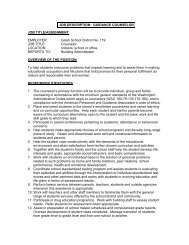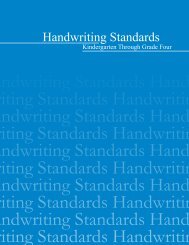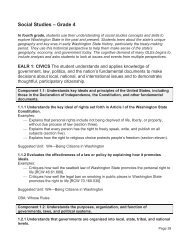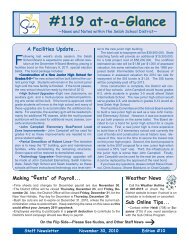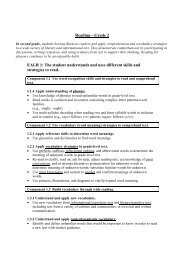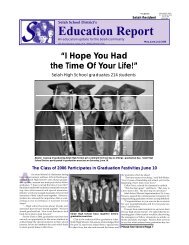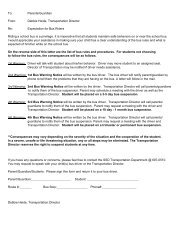Math Vocabulary List
Math Vocabulary List
Math Vocabulary List
You also want an ePaper? Increase the reach of your titles
YUMPU automatically turns print PDFs into web optimized ePapers that Google loves.
Terms Introduced in the<br />
Grades K–4 Glossary:<br />
acute<br />
addend<br />
angle<br />
associative property of addition<br />
associative property of multiplication<br />
average<br />
axes<br />
bar graph<br />
capacity<br />
cardinal number<br />
central tendency<br />
circle<br />
circumference<br />
common denominator<br />
common multiple<br />
commutative property of addition<br />
commutative property of multiplication<br />
cone<br />
congruent figures<br />
cylinder<br />
data<br />
denominator<br />
difference<br />
discrete<br />
dividend<br />
divisible<br />
divisor<br />
edge<br />
equation<br />
equilateral<br />
estimate<br />
even number<br />
expanded form<br />
face<br />
fact<br />
factor<br />
figure<br />
flip<br />
fraction<br />
fraction families<br />
grid<br />
hexagon<br />
horizontal<br />
identity property of addition<br />
identity property of multiplication<br />
inequality<br />
integer<br />
intersecting lines<br />
isosceles triangle<br />
line<br />
line graph<br />
line of symmetry<br />
mean<br />
measure of central tendency<br />
median<br />
mixed number<br />
mode<br />
multiple<br />
nonstandard units of measure<br />
number line<br />
number sentence<br />
numerator<br />
obtuse<br />
octagon<br />
odd number<br />
operation<br />
ordered pair<br />
ordinal number<br />
parallel lines<br />
parallelogram<br />
pattern<br />
pentagon<br />
perimeter<br />
perpendicular lines<br />
point<br />
polygon<br />
polyhedron<br />
probability<br />
product<br />
pyramid<br />
quadrilateral<br />
quotient<br />
ray<br />
rectangle<br />
reflection<br />
regular polygon<br />
Copyright © 1999 State of Washington. Superintendent of Public Instruction. All rights reserved. 29
emainder<br />
rhombus<br />
right angle<br />
right triangle<br />
rotation<br />
sample<br />
scalene<br />
side<br />
similar figures<br />
slide<br />
solid<br />
sphere<br />
square<br />
standard form<br />
standard units of measure<br />
sum<br />
survey<br />
symmetrical<br />
transformation<br />
translation<br />
trapezoid<br />
trend<br />
triangle<br />
turn<br />
variable<br />
vertex<br />
vertical<br />
volume<br />
whole number<br />
word form<br />
Copyright © 1999 State of Washington. Superintendent of Public Instruction. All rights reserved. 30
Terms Introduced in the<br />
Grades 5–7 Glossary:<br />
analyze<br />
approximate<br />
argument<br />
chart<br />
combination<br />
compare<br />
conclude<br />
conjecture<br />
contrast<br />
cube<br />
diagram<br />
distributive property of multiplication<br />
over addition<br />
equivalent fractions<br />
evaluate<br />
evidence<br />
exponent<br />
expression<br />
function machine<br />
gram<br />
graph<br />
greatest common factor<br />
improper fraction<br />
infer<br />
interpret<br />
investigate<br />
irrational number<br />
justify<br />
least common multiple<br />
liter<br />
meter<br />
method<br />
metric prefixes<br />
order of operations<br />
outlier<br />
percent<br />
place value<br />
population<br />
precision<br />
predict<br />
prime number<br />
prism<br />
proportion<br />
random sample<br />
ratio<br />
rational number<br />
real number<br />
reasonable<br />
represent<br />
revise<br />
rule<br />
sample space<br />
sequence<br />
simplest form<br />
solution<br />
solve<br />
stem-and-leaf plot<br />
strategy<br />
symbol<br />
table<br />
t-chart<br />
three-dimensional figure<br />
two-dimensional figure<br />
unknown<br />
validate<br />
verify<br />
zero property of addition<br />
zero property of multiplication<br />
Copyright © 1999 State of Washington. Superintendent of Public Instruction. All rights reserved. 31
A Framework for Achieving the Essential Academic Learning<br />
Requirements in <strong>Math</strong>ematics Grades 5–7 Glossary<br />
acute<br />
addend<br />
see angle and triangle<br />
any number that is added<br />
addend + addend = sum<br />
analyze<br />
angle<br />
to break up a whole into its parts; to examine in detail so as to determine the<br />
nature of<br />
two rays that share an endpoint; named according to the number of degrees of<br />
its measure<br />
acute angle<br />
(greater than 0°<br />
but less than 90°)<br />
right angle<br />
(equal to 90°)<br />
obtuse angle<br />
(greater than 90°<br />
but less than 180°)<br />
straight angle<br />
(equal to 180°)<br />
approximate<br />
argument<br />
associative property<br />
of addition<br />
to obtain a number close to an exact amount<br />
a reason or reasons offered for or against something; suggests the use of logic and<br />
facts to support or refute a point<br />
the sum stays the same when the grouping of addends is changed<br />
Example: (a b) c a (b c)<br />
(30 4) 20 30 (4 20)<br />
associative property<br />
of multiplication<br />
the product stays the same when the grouping of factors is changed<br />
Example: (a b) c a (b c)<br />
(2 3) 4 2 (3 4)<br />
average<br />
a measure of central tendency; a number somewhere in the middle of data ordered<br />
from least to greatest, or a number with a lot of data clustered around it. There are<br />
three types of averages: mean, median, and mode.<br />
Copyright © 1999 State of Washington. Superintendent of Public Instruction. All rights reserved. 32
axes<br />
perpendicular lines used as reference lines in a coordinate system or graph; the<br />
horizontal line is the x-axis; the vertical line is the y-axis<br />
y<br />
3<br />
2<br />
1<br />
-3 -2 -1<br />
-1<br />
0 1 2 3<br />
-2<br />
-3<br />
x<br />
bar graph<br />
a graph that uses the length of solid bars to represent numbers and compare data<br />
Favorite Dog Breed Survey<br />
12<br />
Number of Votes<br />
10<br />
8<br />
6<br />
4<br />
2<br />
0<br />
Cocker<br />
Spaniel<br />
Collie<br />
German<br />
Shepherd<br />
Golden<br />
Retriever<br />
Poodle<br />
Doberman<br />
Chihuahua<br />
None<br />
Breed of Dog<br />
capacity<br />
cardinal number<br />
the volume of material or liquid that can be poured into a container<br />
a number that designates the “manyness” of a set of objects, or the number of<br />
units in the set; answers the question “How many…”<br />
Example: 34 and 50,098<br />
Copyright © 1998 1999 State of Washington. Superintendent of Public Instruction. All rights reserved. 33
central tendency<br />
a single number that describes all the numbers in a set<br />
Example: For the set of numbers 95, 86, 82, and 83, the mean is 89.<br />
chart<br />
circle<br />
a method of displaying information in the form of graphs or tables<br />
a set of points in a plane that are all the same distance from the center point<br />
p<br />
circumference<br />
the boundary line, or perimeter, of a circle; also, the length of the perimeter of a circle<br />
circumference<br />
combination<br />
common denominator<br />
a group of objects, numbers, or events; changing the order does not create a new<br />
combination (1, 2, 3 is the same combination as 3, 1, 2)<br />
a number divisible by all of the denominators being considered; also known as a<br />
common multiple of the denominators<br />
Example: 1 2 1 3 <br />
Multiples of 2 {0, 2, 4, 6, 8, 10, 12,…}<br />
Multiples of 3 {0, 3, 6, 9, 12, 15,…}<br />
Multiples common to both sets, other than zero, include 6 and 12. (There are<br />
infinite numbers of common multiples as the sets continue, i.e., 18, 24, 36, etc.)<br />
Any of these numbers can be used as common denominators for the two fractions.<br />
6 <br />
2<br />
4 <br />
2<br />
5 6 1 0<br />
1<br />
2<br />
1 2 3 6 OR 1 2 1<br />
1 3 2 6 1 3 1<br />
Copyright © 1999 State of Washington. Superintendent of Public Instruction. All rights reserved. 34
common multiple<br />
a number that is a multiple of each of two or more numbers; used to find a common<br />
denominator when operating with fractions having unlike denominators<br />
Example: 24 is a common multiple of 2, 3, and 8<br />
commutative property<br />
of addition<br />
it makes no difference in which order two numbers are added (the commutative<br />
property does not apply to subtraction)<br />
Example:<br />
a b b a<br />
4 50 50 4<br />
commutative property<br />
of multiplication<br />
it makes no difference in which order two numbers are multiplied (the commutative<br />
property does not apply to division)<br />
Example:<br />
a b b a<br />
3 5 5 3<br />
compare<br />
conclude<br />
cone<br />
to look for similarities and/or differences<br />
to make a judgment or decision after investigating or reasoning; to infer<br />
a three-dimensional figure with one circular or elliptical base and a curved surface<br />
that joins the base to the vertex<br />
cones<br />
vertex<br />
vertex<br />
congruent figures<br />
figures that have the same shape and size<br />
congruent triangles<br />
conjecture<br />
contrast<br />
cube<br />
inference or judgment based on inconclusive or incomplete evidence; guesswork<br />
to emphasize differences<br />
a rectangular prism having six congruent square faces<br />
Copyright © 1999 State of Washington. Superintendent of Public Instruction. All rights reserved. 35
cylinder<br />
a solid figure with two circular or elliptical bases that are congruent and parallel<br />
to each other<br />
data<br />
denominator<br />
diagram<br />
difference<br />
discrete<br />
collected pieces of information<br />
the number below the fraction bar; indicates the number of equivalent pieces into<br />
which something is divided<br />
a drawing that represents a mathematical situation<br />
the number found when subtracting one number from another; the result of<br />
a subtraction operation; the amount by which a quantity is more or less<br />
than another number<br />
composed of distinct parts or discontinuous elements; a set of numbers, or points,<br />
that has no limit points<br />
Example:<br />
discrete — taking coins out of your pocket one at a time;<br />
non-discrete (or continuous) — pouring water from one container to<br />
another container<br />
distributive a property of real numbers stating that a (b c) (a b) (a c)<br />
property of<br />
where a, b, and c stand for any real numbers<br />
multiplication<br />
over addition Example: 3 (40 5) (3 40) (3 5)<br />
dividend<br />
a number which is to be divided by another number<br />
dividend divisor quotient 15 3 5<br />
quotient<br />
divisor dividend<br />
5<br />
3 15<br />
divisible<br />
divisor<br />
a whole number is divisible by another whole number if the remainder equals zero<br />
when you divide<br />
the number by which the dividend is to be divided; also a factor<br />
quotient<br />
divisor dividend<br />
dividend<br />
.<br />
divisor = quotient<br />
Copyright © 1999 State of Washington. Superintendent of Public Instruction. All rights reserved. 36
edge<br />
the line segment formed by the intersection of two faces of a solid figure;<br />
a cube has 12 edges<br />
edge<br />
edge<br />
equation<br />
a number sentence which shows equality between two sets of values<br />
Example: 4 8 6 6<br />
equilateral<br />
equivalent<br />
fractions<br />
estimate<br />
evaluate<br />
even number<br />
see triangle<br />
fractions that name the same number<br />
9<br />
Example: 3 4 and 6 8 and are equivalent fractions<br />
12 to find an approximate value or measurement of something<br />
to examine and judge carefully; appraise<br />
a whole number divisible by two<br />
Example: 0, 4, 678<br />
evidence<br />
expanded form<br />
models, known facts, patterns, relationships, and counterexamples<br />
a number written in component parts showing the cumulative place values of<br />
each digit in the number<br />
Example: 546 500 40 6<br />
exponent<br />
a numeral written above and to the right of another numeral to indicate how many<br />
times the original number is used as a factor<br />
Example: The exponent “3” in 4 3 means 4 is a factor 3 times, 4 4 4.<br />
expression<br />
a variable or combination of variables, numbers, and symbols that represent a<br />
mathematical relationship<br />
Copyright © 1999 State of Washington. Superintendent of Public Instruction. All rights reserved. 37
face<br />
a flat surface, or side, of a solid figure<br />
face<br />
face<br />
fact a basic mathematical statement involving numbers and operations; ex. 3 5 = 8,<br />
10 2 5<br />
factor<br />
one of two or more numbers that are multiplied together to obtain a<br />
product; factor factor product<br />
Example: 4 3 12, 4 and 3 are factors<br />
figure<br />
flip<br />
fraction<br />
a closed geometric shape in 2 or 3 dimensions<br />
the effect of a flip is a reflection; see reflection<br />
a way of representing part of a whole or part of a group by telling the number of<br />
equal parts in the whole and the number of those parts you are describing; it is<br />
written in the form<br />
numerator<br />
d<br />
where the numerator can be any integer and the<br />
enominator<br />
denominator can be any integer except zero<br />
Example: 2 3 , 5 6<br />
2<br />
3, 16<br />
76<br />
5, 0<br />
3<br />
4, 8 1 <br />
fraction families<br />
fractions having denominators that are multiples of a single number; ex. halves,<br />
fourths, eighths, and sixteenths; thirds, sixths, and ninths<br />
5<br />
Example: 2 4 , 3 8 , have denominators that are multiples of 4<br />
12<br />
function<br />
machine<br />
applies a function rule to a set of numbers which determines a<br />
corresponding set of numbers<br />
Example:<br />
9 ➞ Input ➞<br />
Rule<br />
x 7<br />
➞ Output ➞ 63<br />
If you apply the function rule “multiply by 7” to the values 5, 7, and 9,<br />
the corresponding values would be:<br />
5 ➞ 35<br />
7 ➞ 49<br />
9 ➞ 63<br />
Copyright © 1999 State of Washington. Superintendent of Public Instruction. All rights reserved. 38
gram<br />
graph<br />
greatest common<br />
factor<br />
grid<br />
a basic unit in the metric system measuring mass/weight; the mass of 1 cubic<br />
centimeter of water at 4 degrees Celsius<br />
a “picture” showing how certain facts are related to each other or how they compare<br />
to one another<br />
the largest factor of two or more numbers; often abbreviated as GCF<br />
Example: to find the greatest common factor of 24 and 36<br />
factors of 24 {1, 2, 3, 4, 6, 8, 12, 24}<br />
factors of 36 {1, 2, 3, 4, 6, 9, 12, 18, 36}<br />
common factors of 24 and 36 are {1, 2, 3, 4, 6, 12}, the largest being 12<br />
12 is the greatest common factor of 24 and 36<br />
a pattern of regularly spaced horizontal and vertical parallel lines drawn on a map or<br />
chart with ordered pairs of numbers that can be used to locate points<br />
4<br />
3<br />
2<br />
1<br />
0 1 2<br />
3<br />
(3, 4)<br />
4<br />
hexagon<br />
a six-sided polygon<br />
regular hexagon<br />
nonregular hexagons<br />
horizontal<br />
identity property<br />
of addition<br />
identity property<br />
of multiplication<br />
improper fraction<br />
extending side to side, parallel to the horizon<br />
adding zero to a number gives a sum identical to the given number<br />
multiplying a number by 1 gives a product identical to the given number<br />
a fraction in which the numerator is equal to or greater than the denominator<br />
Example: 1 5<br />
1<br />
, 5 5 3 <br />
inequality<br />
infer<br />
integer<br />
two sets of values that are not equal<br />
to draw a conclusion from facts or evidence<br />
the counting numbers (1, 2, 3,...), their opposites (-1, -2, -3,...), and zero<br />
Copyright © 1999 State of Washington. Superintendent of Public Instruction. All rights reserved. 39
interpret<br />
intersecting lines<br />
to explain the meaning of information, facts, and/or observation<br />
lines that meet at a point<br />
P<br />
investigate<br />
irrational number<br />
to research using careful observation and examination of the facts; to inquire<br />
a number that cannot be expressed as a ratio of two integers<br />
Example: 2<br />
isosceles triangle<br />
a triangle with 2 congruent sides; an alternate definition is a triangle with at least<br />
2 congruent sides (there is no common agreement on a definition of an isosceles<br />
triangle)<br />
justify<br />
least common<br />
multiple<br />
to prove or show to be true or valid using logic and/or evidence<br />
the smallest number, besides zero, that is a multiple of a set of two or more<br />
numbers; often abbreviated LCM<br />
Example: to find the least common multiple of 4 and 12<br />
multiples of 4 {0, 4, 8, 12, 16,…}<br />
multiples of 12 {0, 12, 24, 36,…}<br />
The lowest common number besides 0 in both sets is 12, so the LCM of 4 and<br />
12 is 12.<br />
line<br />
a set of points extending infinitely in opposite directions<br />
Copyright © 1999 State of Washington. Superintendent of Public Instruction. All rights reserved. 40
line graph<br />
a graph that uses a line to show that something is increasing, decreasing, or<br />
staying the same over time<br />
Amount of Snow Fall<br />
12<br />
Inches of Snow<br />
10<br />
8<br />
6<br />
4<br />
2<br />
0<br />
Nov. Dec. Jan. Feb. Mar. Apr.<br />
line of symmetry<br />
a line on which a figure can be folded into two parts that are congruent mirror<br />
images of each other<br />
not a line<br />
of symmetry<br />
line of<br />
symmetry<br />
not a line of<br />
symmetry<br />
liter<br />
mean<br />
a basic unit of measure in the metric system measuring capacity/volume; one<br />
cubic decimeter; a little more than a quart; 1000 cubic centimeters<br />
an average obtained by dividing the sum of the data items by the number of data<br />
items<br />
Example: If there are three classes: A 24 children, B 25 children, and<br />
C 23 children, the classes would be balanced by moving one student from<br />
class B to class C, thus making each class the same size (24). This number<br />
would indicate the average class size. Arithmetically, it is obtained by adding all<br />
data points together and dividing the sum by the number of points<br />
(24 25 23 72; 72 divided by 3 24).<br />
measure of central<br />
tendency<br />
see average<br />
Copyright © 1999 State of Washington. Superintendent of Public Instruction. All rights reserved. 41
median<br />
the number in the middle of a set of data arranged in order from least to greatest<br />
or from greatest to least; or the average of the two middle terms if there is an<br />
even number of terms<br />
Example:<br />
For the data: 6, 14, 23, 46, 69, 72, 94 ➜ The median is 46 (the middle number)<br />
For the data: 6, 14, 23, 69, 72, 94 ➜ The median is also 46 (the average of the<br />
two middle numbers in the list)<br />
meter<br />
method<br />
metric prefixes<br />
a unit of linear measure in the metric system, a little more than a yard<br />
a systematic way of accomplishing a task<br />
prefixes used to describe the relationship between measures in the metric<br />
system; the most common prefixes are:<br />
kilo- hecto- deka- (unit) deci- centi- milli-<br />
(k) (h) (da) (g,m,l) (d) (c) (m)<br />
1000 100 10 1 1/10 1/100 1/1000<br />
Example: 2 kg 2 kilograms 2000 grams<br />
3 cm 3 centimeters .03 m<br />
mixed number<br />
a number expressed as the sum of an integer and a fraction<br />
Example: 6 2 3 <br />
mode<br />
the number that occurs most frequently in a set of data<br />
Example: For the set of data {42, 36, 75, 75, 80}, 75 is the mode because it<br />
occurs most often. For the set of data {25, 45, 25, 55, 45, 65}, 25 and 45 are the<br />
modes. If no number occurs most often, then the set of data has no mode.<br />
multiple<br />
a number that is divisible by a given factor; a multiple of a whole number can be<br />
found by multiplying it by any whole number other than one<br />
Example: 56 is a multiple of 7; 0 is a multiple of 34<br />
nonstandard<br />
units of measure<br />
measurement units that are not commonly accepted as standard but are<br />
applied uniformly when measuring<br />
Example: paperclips, pencils, cubes<br />
Copyright © 1999 State of Washington. Superintendent of Public Instruction. All rights reserved. 42
number line<br />
a line that shows numbers ordered by magnitude from left to right or bottom to<br />
top; an arrowhead at each end indicates that the line continues endlessly in both<br />
directions; points are marked to subdivide the line into intervals that correspond<br />
to indicated numbers<br />
-2 -1 0 1 2<br />
-1 2.7<br />
number lines<br />
3<br />
2<br />
1<br />
0<br />
-1<br />
-2<br />
-3<br />
number sentence<br />
an expression of a relationship between quantities as an equation or an inequality<br />
Example: 7 7 8 6<br />
14 92<br />
56 4 59<br />
numerator<br />
obtuse<br />
octagon<br />
the number above the line in a fraction; indicates the number of equivalent parts<br />
being considered<br />
see angle and triangle<br />
an eight-sided polygon<br />
regular<br />
octagon<br />
nonregular<br />
octagons<br />
odd number<br />
a whole number that is not divisible by two<br />
Example: 53, 701<br />
operation<br />
a mathematical process that combines numbers; basic operations of<br />
arithmetic include addition, subtraction, multiplication, and division<br />
Copyright © 1999 State of Washington. Superintendent of Public Instruction. All rights reserved. 43
ordered pair<br />
order of<br />
operations<br />
two numbers for which their order is important when used to locate points on a<br />
coordinate graph; the first element indicates distance along the x-axis<br />
(horizontal) and the second indicates distance along the y-axis (vertical);<br />
see illustration for grid<br />
rules describing the order to use in evaluating numerical expressions:<br />
the order is parentheses, exponents, multiply/divide, add/subtract<br />
Example: 7 3 8 31 [multiply 3 8 before adding 7]<br />
ordinal number<br />
a number that designates the position of an object in order; first, second, and third<br />
are examples of ordinal numbers<br />
Example: Eraser is the SECOND element in the set (pencil, eraser, desk,<br />
chalkboard, book, file, paper); Z is the TWENTY-SIXTH element in the set<br />
(a, b, c, d,…, z).<br />
outlier<br />
parallel lines<br />
a number in a set of data that is much larger or smaller than most of the other<br />
numbers in the set<br />
lines that lie in the same plane and never intersect<br />
parallelogram<br />
a quadrilateral with opposite sides parallel<br />
parallelograms<br />
pattern<br />
the arrangement of numbers, pictures, etc. in an organized and predictable way<br />
Example:<br />
3, 6, 9, 12, …<br />
□ △ □ △ □ △<br />
Copyright © 1999 State of Washington. Superintendent of Public Instruction. All rights reserved. 44
pentagon<br />
a five-sided polygon<br />
regular<br />
pentagon<br />
nonregular<br />
pentagon<br />
percent a special ratio that compares a number to 100 using the symbol %<br />
Example: 40% 1<br />
4<br />
<br />
0<br />
00<br />
perimeter<br />
perpendicular lines<br />
the distance around the outside of a shape or figure<br />
lines that lie on the same plane that intersect to form right angles (90 degrees)<br />
90°<br />
90°<br />
place value<br />
the value of a digit as determined by its place in a number<br />
Example: In the number 135, the 3 means 3 • 10 or 30; in the number 356, the 3<br />
means 3 • 100 or 300.<br />
point<br />
polygon<br />
polyhedron<br />
an exact position in space<br />
a closed plane figure having three or more straight sides<br />
a solid figure, the sides of which are polygons<br />
Example:<br />
population<br />
precision<br />
a group of people, objects, or events that fit a particular description<br />
an indication of how finely a measurement is made; related to the unit of<br />
measurement and the calibration of the tool<br />
1<br />
Example: Was the measurement made using a ruler marked in increments of 4 "<br />
1<br />
or increments of " <br />
16<br />
Copyright © 1999 State of Washington. Superintendent of Public Instruction. All rights reserved. 45
predict<br />
prime number<br />
prism<br />
to tell about or make known in advance, especially on the basis of special<br />
knowledge or inference; to make an educated guess<br />
a number having exactly 2 factors (1 and itself); the first five prime numbers are<br />
2, 3, 5, 7, 11<br />
a 3-dimensional figure that has 2 congruent and parallel faces that are polygons<br />
and the remaining faces are parallelograms<br />
Example:<br />
probability<br />
product<br />
the numerical measure of the chance that a particular event will occur, depending<br />
on the possible events; the probability of an event is always between 0 and 1, with<br />
0 meaning that there is no chance of occurrence and 1 meaning a certainty of<br />
occurrence<br />
the result of a multiplication expression; factor factor = product<br />
Example: 3 4 12, 12 is the product<br />
proportion<br />
an equation showing that two ratios are equivalent<br />
Example: 2 3 <br />
6 9 <br />
pyramid<br />
a solid whose base is a polygon and whose faces are triangles that meet at a<br />
common point (vertex)<br />
vertex<br />
vertex<br />
pyramids<br />
Copyright © 1999 State of Washington. Superintendent of Public Instruction. All rights reserved. 46
quadrilateral<br />
a four-sided polygon<br />
square<br />
rectangle parallelogram trapezoid<br />
quadrilaterals<br />
nonregular<br />
quadrilateral<br />
rhombus<br />
quotient<br />
the result of dividing one number by another number<br />
quotient<br />
divisor dividend<br />
dividend divisor quotient<br />
random sample<br />
ratio<br />
a sample in which every person, object, or event in the population has the same<br />
chance of being selected for the sample<br />
a comparison of two numbers using division<br />
Example: The ratio of two to five is 2:5 or 2 5 .<br />
rational number<br />
ray<br />
real number<br />
reasonable<br />
a number that can be expressed as a ratio of two integers<br />
34<br />
432<br />
2<br />
Example: 34 can be written as , 4.32 can be written as , 3 1 1<br />
100<br />
can be<br />
2<br />
written as 7 2 <br />
a part of a line that has one end point and extends infinitely in one<br />
direction<br />
any rational or irrational number<br />
within likely bounds; sensible<br />
Example: A reasonable estimate is close to the actual answer; an answer of<br />
1<br />
2 cans is not reasonable, while 2 cans or 3 cans is reasonable.<br />
Copyright © 1999 State of Washington. Superintendent of Public Instruction. All rights reserved. 47
ectangle<br />
a parallelogram with right angles; a square is a special rectangle<br />
reflection<br />
a transformation of a figure by reflecting it over a line, creating a mirror image<br />
of the figure; the effect of a flip is a reflection<br />
reflection<br />
reflection<br />
regular polygon<br />
a polygon with equal sides and equal angles<br />
regular polygons<br />
remainder<br />
the undivided part that is left after division; it is less than the divisor<br />
Example:<br />
5 r 2<br />
6 32<br />
30<br />
2<br />
Copyright © 1999 State of Washington. Superintendent of Public Instruction. All rights reserved. 48
epresent<br />
revise<br />
rhombus<br />
to present clearly; describe; show<br />
to change or modify based on guess and check or on reflection and evaluation<br />
a parallelogram with all four sides equal in length<br />
right angle<br />
an angle whose measure is 90 degrees; see angle and triangle<br />
90°<br />
right triangle<br />
a triangle having one right angle; see angle and triangle<br />
rotation<br />
turning a figure around a given point<br />
A<br />
B<br />
rotation<br />
C<br />
B'<br />
A'<br />
Copyright © 1999 State of Washington. Superintendent of Public Instruction. All rights reserved. 49
ule<br />
a procedure; a prescribed method; a way of describing the relationship between<br />
two sets of numbers<br />
Example: In the following data, the rule is to add 3.<br />
Input Output<br />
3 6<br />
5 8<br />
9 12<br />
sample<br />
a portion of a population or set used in statistics<br />
Example:<br />
All boys under the age of ten constitute a sample of the population<br />
of all male children.<br />
sample space<br />
scalene<br />
sequence<br />
side<br />
a list of all possible outcomes of an activity<br />
see triangle<br />
a set of numbers arranged in a special order or pattern<br />
a line segment connected to other segments to form the boundary of a polygon<br />
side<br />
similar figures<br />
having the same shape but not necessarily the same size (congruent<br />
corresponding angles and proportional corresponding sides)<br />
similar triangles<br />
similar hexagons<br />
Copyright © 1999 State of Washington. Superintendent of Public Instruction. All rights reserved. 50
simplest form a fraction with a numerator and denominator having no common factor except 1<br />
Example: The fraction<br />
2<br />
3<br />
is in simplest form, because the only number that evenly<br />
divides 2 and 3 is 1; the fraction is NOT in simplest form, because 4 and 10<br />
both have a factor of 2.<br />
4<br />
10<br />
slide<br />
solid<br />
solution<br />
solve<br />
sphere<br />
the effect of a slide is a translation; see translation<br />
a geometric figure with three dimensions<br />
result; answer; the process of finding the answer<br />
to find an answer or solution to a problem<br />
a closed surface consisting of all points in space that are the same distance from<br />
a given point (the center)<br />
ball<br />
square<br />
a rectangle with congruent sides<br />
standard form<br />
a number written with one digit for each place value<br />
Example: The standard form for five hundred forty-six is 546.<br />
The standard form for three thousand six is 3,006.<br />
standard units<br />
of measure<br />
units of measure commonly used, generally classified in the U.S. customary<br />
system or metric system<br />
Example: feet, meters, acres, gallons, liters<br />
Copyright © 1999 State of Washington. Superintendent of Public Instruction. All rights reserved. 51
stem-and-leaf<br />
plot<br />
a method of organizing data from least to greatest using the digits of the greatest<br />
place value to group data<br />
Example:<br />
Ages of Adults at the Park<br />
Data set Stem Leaves<br />
23 25 29 29 2 3 5 9 9<br />
36 38 39 39 3 6 8 9 9<br />
52 54 55 55 5 2 4 5 5<br />
Key: 2|3 represents 23 years<br />
strategy<br />
sum<br />
a tool used in problem solving, such as looking for a pattern, drawing a diagram,<br />
working backward, etc.<br />
the result of addition<br />
addend addend sum<br />
survey<br />
symbol<br />
symmetrical<br />
to get an overview by gathering data<br />
a character used to represent operations, numbers, or relationships between<br />
numbers<br />
having a line, plane, or point of symmetry such that for every point on the figure,<br />
there is a corresponding point that is the reflection of that point (see line<br />
of symmetry)<br />
A<br />
B<br />
B'<br />
C<br />
C'<br />
D<br />
symmetrical<br />
symmetry<br />
table<br />
the property of being balanced about a line, plane, or point<br />
a method of displaying data in rows and columns<br />
Copyright © 1999 State of Washington. Superintendent of Public Instruction. All rights reserved. 52
t-chart<br />
a table of values; an input-output table<br />
Example: Input Output<br />
1 4<br />
2 5<br />
3 6<br />
threedimensional<br />
figure<br />
transformation<br />
translation<br />
a shape having length, width, and height<br />
one of three methods for moving a figure without changing its shape or size:<br />
translations (slides), reflections (flips), and rotations (turns)<br />
a transformation of a figure by moving it without turning or flipping it in any<br />
direction; the effect of a slide is a translation<br />
translation<br />
trapezoid<br />
trend<br />
a quadrilateral that has 2 parallel sides; an alternate definition is a quadrilateral<br />
with at least 2 parallel sides (there is no common agreement on a definition of a<br />
trapezoid)<br />
the general direction or tendency of a set of data<br />
Copyright © 1999 State of Washington. Superintendent of Public Instruction. All rights reserved. 53
triangle<br />
a three-sided polygon<br />
Triangles Classified Using Angle Sizes<br />
acute<br />
triangle<br />
(all angles acute)<br />
equiangular<br />
triangle<br />
(all angles equal)<br />
obtuse<br />
triangle<br />
(has one obtuse angle)<br />
right<br />
triangle<br />
(has one 90˚ angle)<br />
Triangles Classified Using Length of Sides<br />
scalene<br />
triangle<br />
(no sides equal)<br />
equilateral<br />
triangle<br />
(all sides equal)<br />
isosceles triangle<br />
(two sides equal)<br />
turn<br />
twodimensional<br />
figure<br />
unknown<br />
see rotation<br />
a shape having length and width<br />
in algebra, the quantity represented by a variable<br />
Example: In the expression 4 • w 24, the letter w is the unknown.<br />
validate<br />
variable<br />
to substantiate, verify, or confirm<br />
a quantity or symbol capable of assuming any of a set of values<br />
Example:<br />
In the expression b < 100, the variable b can be any number less<br />
than 100.<br />
verify<br />
vertex<br />
to establish as true by presentation of evidence<br />
point at which two line segments, lines, or rays meet to form an angle<br />
Example:<br />
vertex<br />
Copyright © 1999 State of Washington. Superintendent of Public Instruction. All rights reserved. 54
vertical<br />
volume<br />
extending straight up and down; perpendicular to the horizon<br />
the number of cubic units it takes to fill a figure<br />
whole number any counting number or zero: 0, 1, 2, 3, . . .<br />
counting numbers<br />
(1, 2, 3, 4, 5, …)<br />
whole numbers<br />
(0, 1, 2, 3, 4, 5, …)<br />
integers<br />
(…-3, -2, -1, 0, 1, 2, 3, …)<br />
rational numbers (fractions)<br />
1 3 8<br />
such as 2, 7, …1, …<br />
word form<br />
the expression of a number in words; reading the symbols<br />
Example: 546 is “five hundred forty-six”<br />
< symbol meaning “is less than”<br />
> symbol meaning “is greater than”<br />
= symbol meaning “equals” or “is equal to”<br />
zero property<br />
of addition<br />
adding zero to a number gives a sum identical to the original number;<br />
zero is the identity element of addition (see identity property)<br />
Example: 4 0 4 56.89 0 56.89<br />
zero property<br />
of multiplication<br />
the product of any number and zero is zero<br />
Example: 4 0 0 0 456.7 0<br />
Copyright © 1999 State of Washington. Superintendent of Public Instruction. All rights reserved. 55


